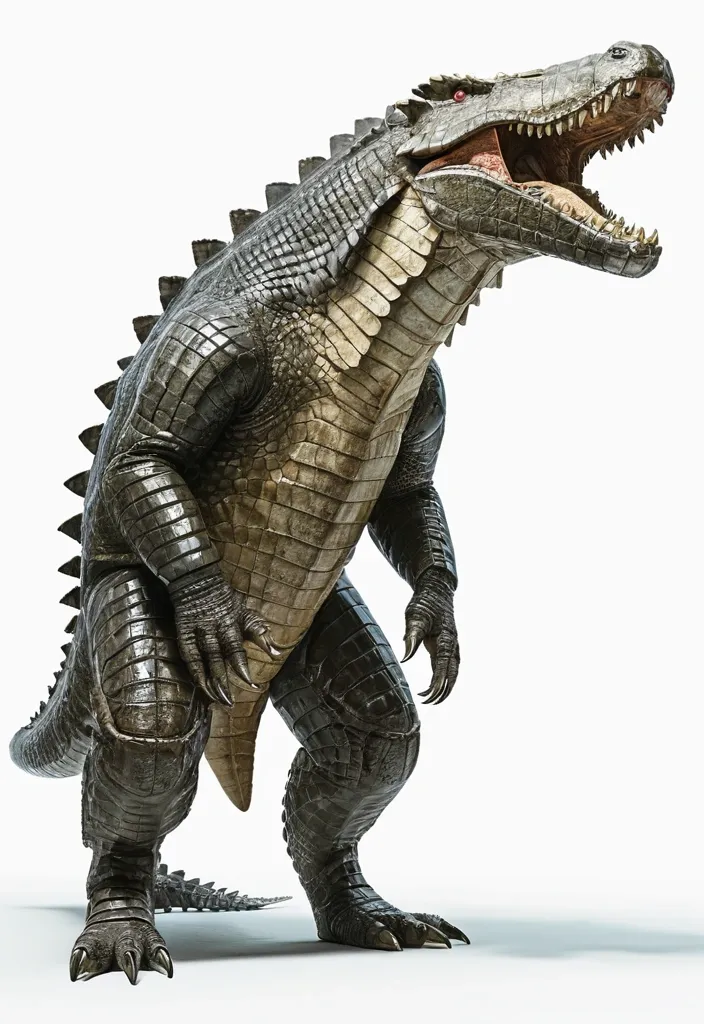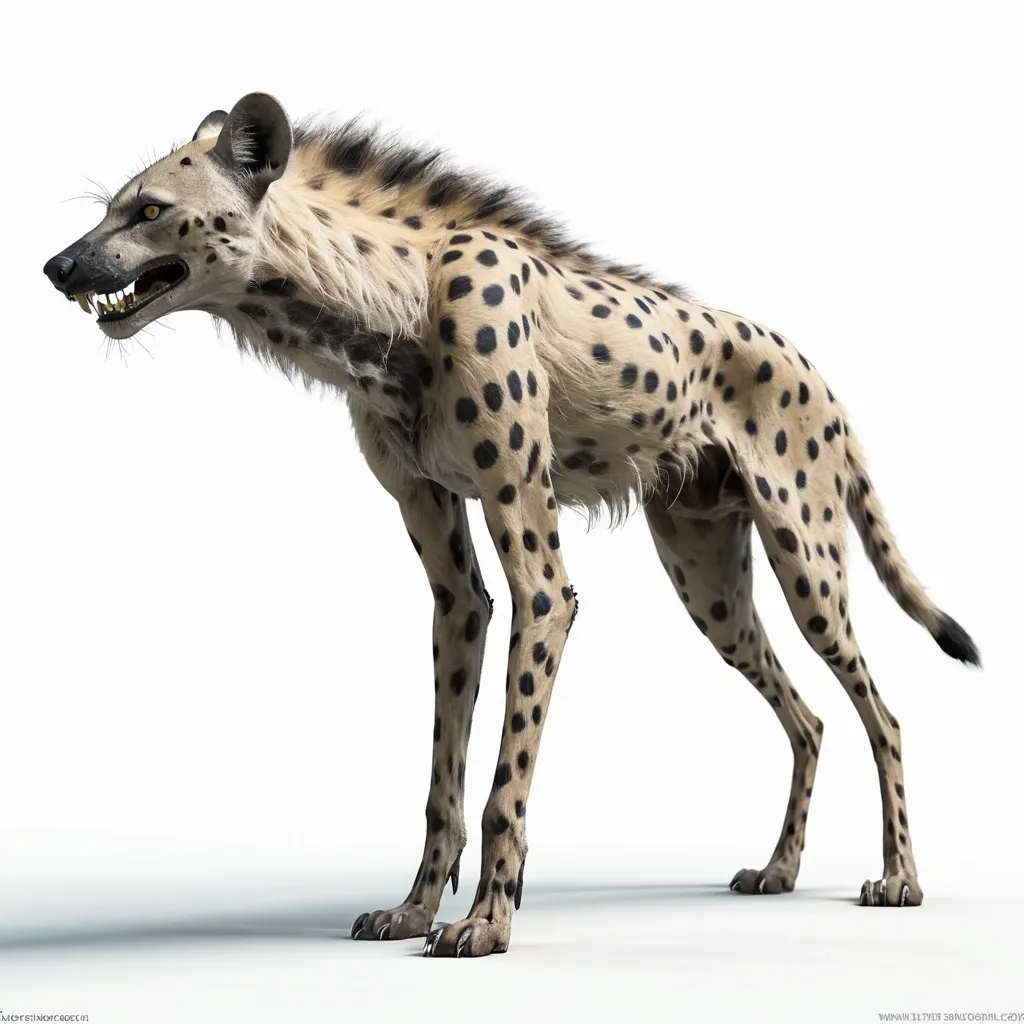Search Results for JAWS
Explore AI generated designs, images, art and prompts by top community artists and designers.
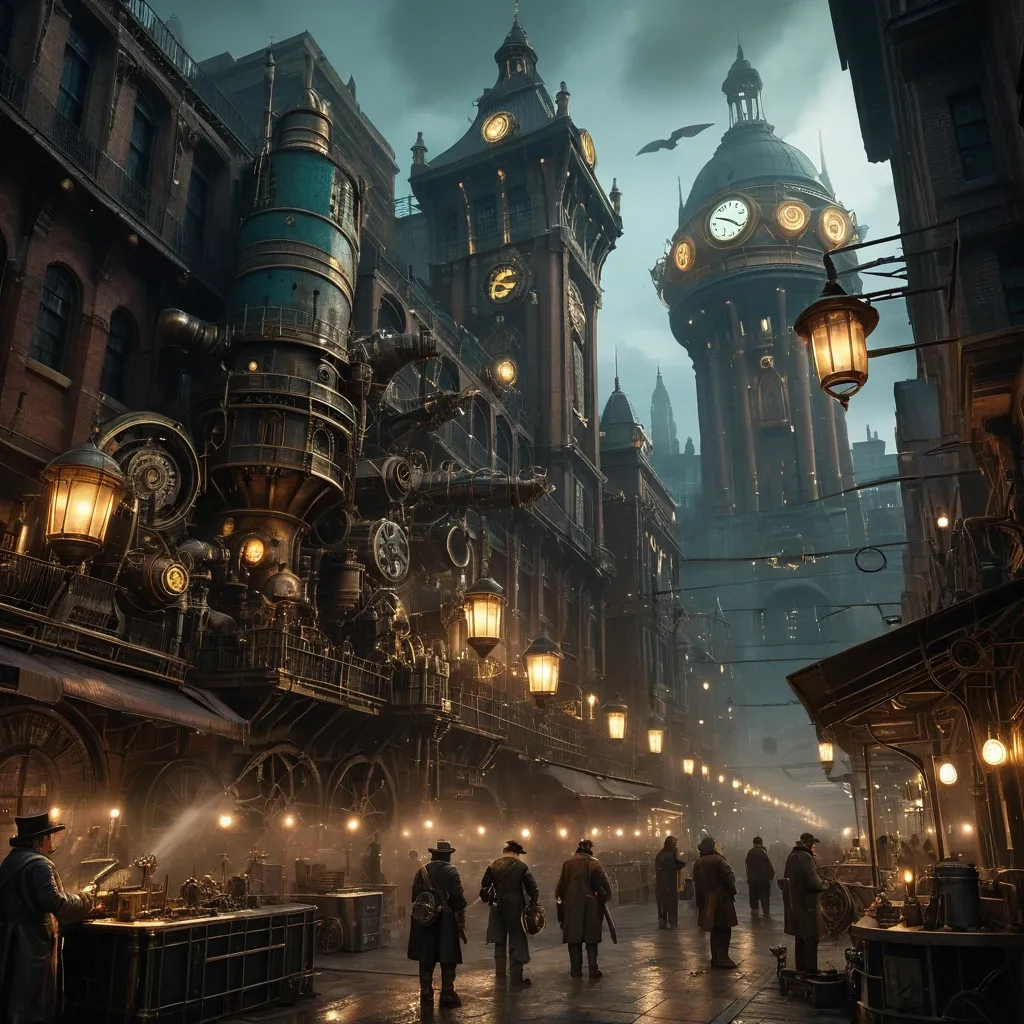
A sprawling **steampunk cityscape** dominated by towering brass-and-copper skyscrapers , their gears and pistons exposed like mechanical veins , belching plumes of thick , golden steam into a perpetually twilight sky. Airships with patched canvas hulls and whirring propellers drift lazily between the buildings , their wooden gondolas adorned with flickering gas lamps and intricate filigree railings. Below , a labyrinth of cobbled streets winds between market stalls selling clockwork trinkets , hissing pneumatic tubes , and jars of glowing alchemical liquids in eerie blues and greens. Goggled engineers in leather aprons tinker with half-assembled automatons , their tools scattered across workbenches cluttered with blueprints and rusted cogs. In the foreground , a grand **central plaza** features a colossal , steam-powered fountain—its water spouting from the jaws of a mechanical dragon , its bronze scales gleaming under the dim glow of arc lamps. The plaza is bustling with life: top-hatted gentlemen adjust their pocket watches , corseted inventors argue over schematics , and street urchins dart between legs , selling stolen gears from their satchels. Above it all , a **massive clock tower** looms , its face cracked and hands moving erratically , as if time itself is unraveling in this city of brass and dreams. The art style blends **hyper-detailed linework** with a **gritty , textured aesthetic**—every surface shows signs of wear , from the tarnished metal of the airships to the scorch marks on the factory smokestacks. The lighting is **moody and dramatic** , with deep shadows cast by the flickering gaslights , while the steam diffuses the glow into an ethereal haze. The color palette is rich yet muted—**burnished coppers , deep browns , and aged brass** dominate , punctuated by the occasional flash of **emerald-green alchemy** or **ruby-red warning lights**. The composition should feel **immersive and alive** , as if the city itself is a living , breathing machine. ,
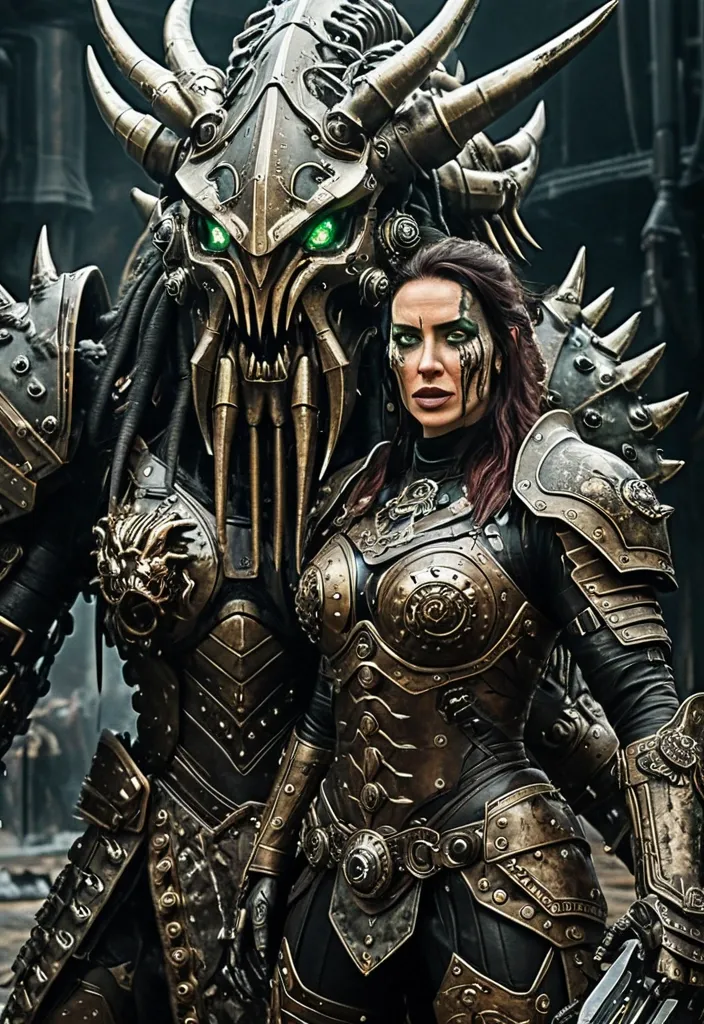
A female warrior standing face-to-face with the massive head of a mechanical Predator , (octopus motif) , green eyes , steampunk like creature. The warrior , wearing heavy battle-worn spartan armor with fur and metal engravings , holding a iPhone taking selfie with mythic energy , cinematic poster style , , her small frame dwarfed by the beast before her. The creature’s head , emerges from a chaotic wash of black splatters and dripping stains , its open jaws revealing jagged teeth that nearly graze the woman's forehead. The dark background is worn , creased , giving the entire composition the feel of a forgotten myth or an artifact of nightmare. ,
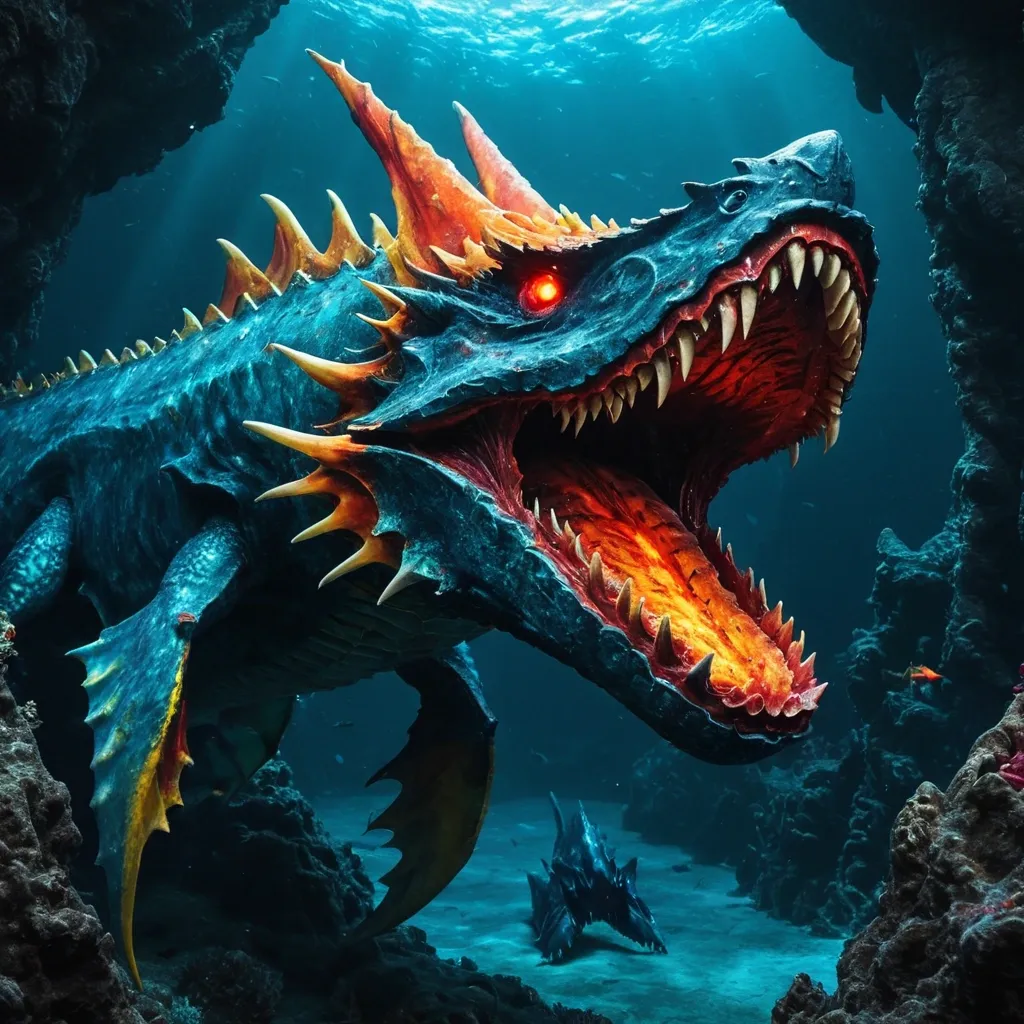
Make an underwater hybrid picture of a megalodon and a dragon. The creature should have the head of a dragon , like in Game of Thrones. The wings are huge and look like glowing lava , colors red , orange , and yellow. The hybrid's body is covered in teal , sky blue , royal blue , and indigo blue scales. The tail has a jagged fin. The back fin is scarred. The dragon's face has high cheekbones bony and big red eyes.. The background is a dark deep sea trench , with an underwater cave entrance and sharks swimming. The creature has its jaws open , with 3 rows of sharp teeth. ,
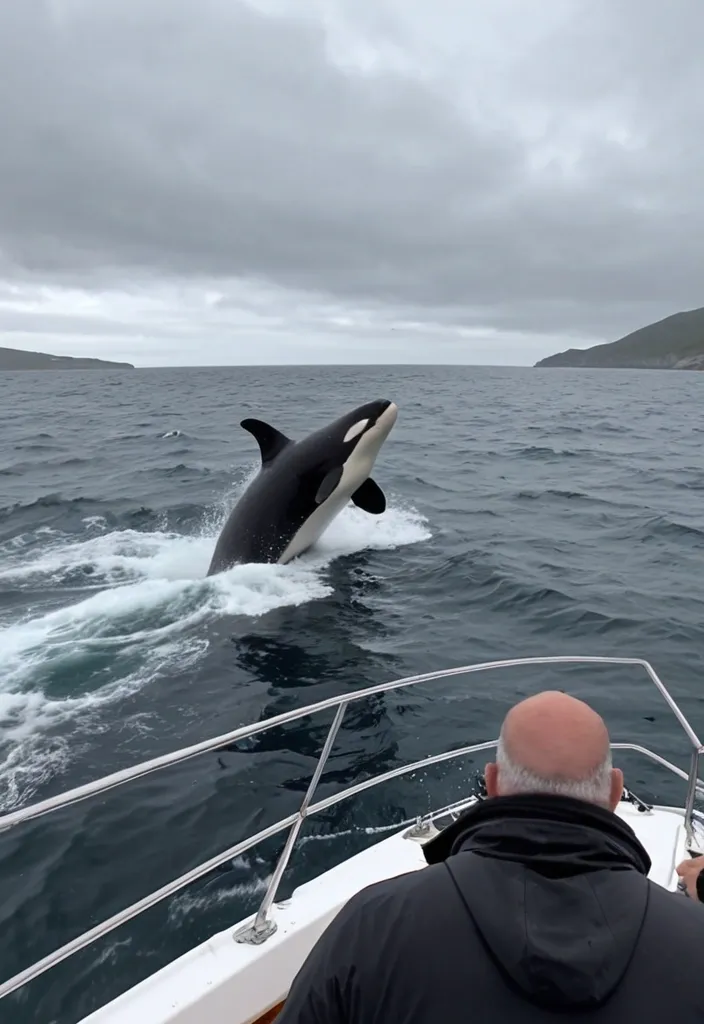
A group of young men are sailing on a small white sailboat in the open ocean. The camera records in a raw , realistic handheld style , as if filmed on a phone by one of the passengers. Suddenly , a massive orca surfaces next to the boat and lunges toward them , opening its jaws wide as it tries to bite one of the men leaning over the edge. The men scream in shock , scrambling back as the camera shakes violently , capturing the orca’s sharp teeth , splashing water , and the terrified reactions on board. The sea is slightly rough , with waves rocking the boat under a cloudy sky. Recorded like an amateur sailing video , unpolished and realistic. ,
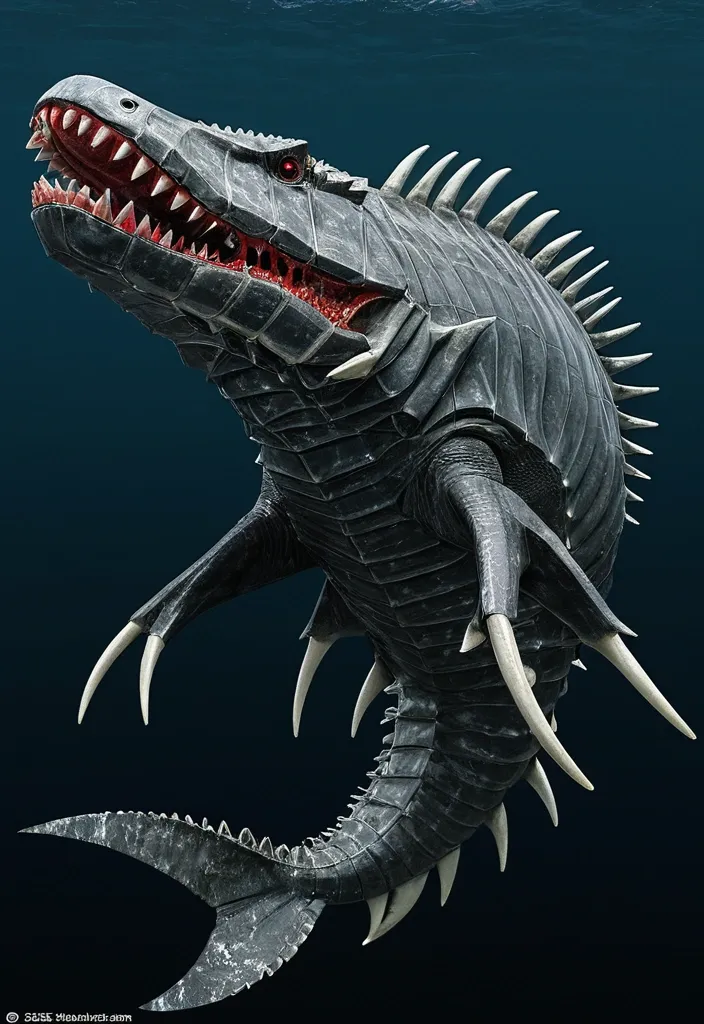
Female , Length: 40-60 feet , Weight: 50-75 tons , Lifespan: 100-135 years , Color is a slate gray base with white and red photophores arranged in tiger stripe patterns along the flanks and dorsal ridge , glowing vividly in abyssal darkness , a Robust , muscular frame combining the thick , armored scales of saltwater crocodile and arapaima with a hydrodynamic , flexible body of Mosasaurus Hoffmannii , Large , rigid pectoral fins capable of tilting backward to reduce drag , inspired by the Black Marlin’s speed adaptations , Powerful flippers adapted for both swimming and short-distance land movement , similar to a leopard seal’s scooting style , Enormous , reinforced jaws with over 40 , 000 PSI bite force , lined with long , razor-sharp canine teeth from Predator X and Megalodon genetics , Venomous spines inspired by the crown-of-thorns starfish line the dorsal ridge , delivering painful wounds to predators or rivals. ,
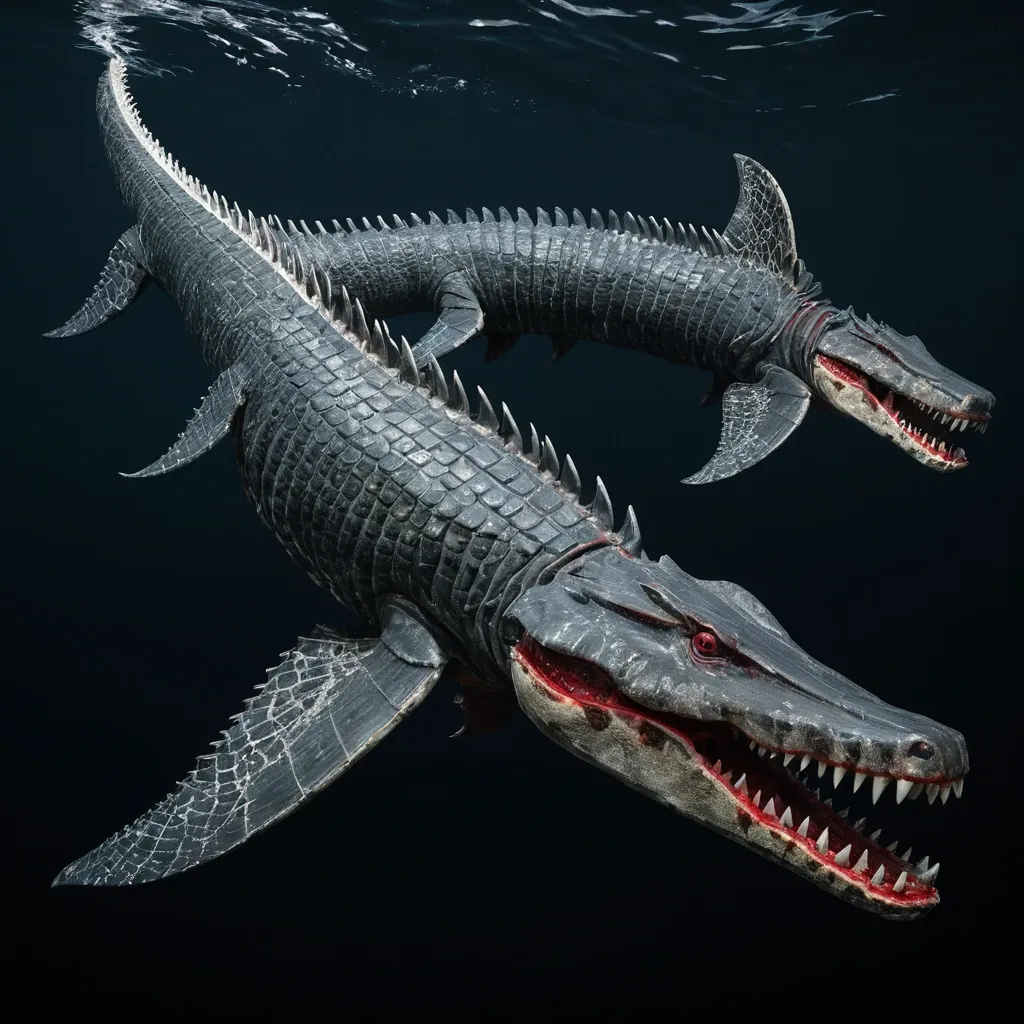
Female , Length: 40-60 feet , Weight: 50-75 tons , Lifespan: 100-135 years , Color is a slate gray base with white and red photophores arranged in tiger stripe patterns along the flanks and dorsal ridge , glowing vividly in abyssal darkness , a Robust , muscular frame combining the thick , armored scales of saltwater crocodile and arapaima with a hydrodynamic , flexible body of Mosasaurus Hoffmannii , Large , rigid pectoral fins capable of tilting backward to reduce drag , inspired by the Black Marlin’s speed adaptations , Powerful flippers adapted for both swimming and short-distance land movement , similar to a leopard seal’s scooting style , Enormous , reinforced jaws with over 40 , 000 PSI bite force , lined with long , razor-sharp canine teeth from Predator X and Megalodon genetics , Venomous spines inspired by the crown-of-thorns starfish line the dorsal ridge , delivering painful wounds to predators or rivals. ,
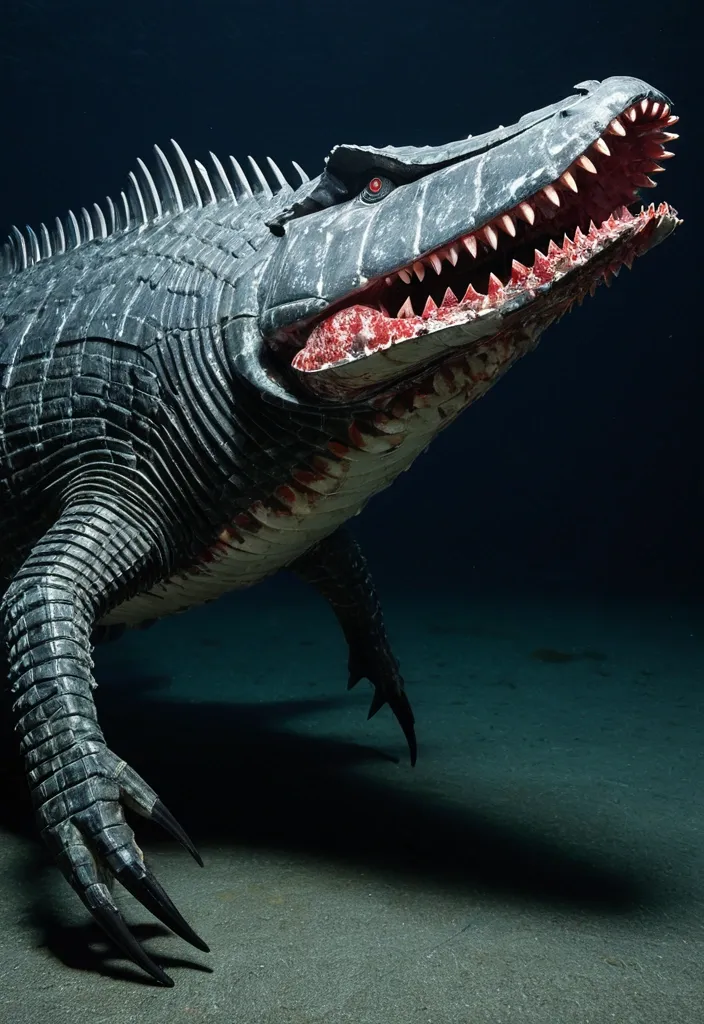
Female , Length: 40-60 feet , Weight: 50-75 tons , Lifespan: 100-135 years , Color is a slate gray base with white and red photophores arranged in tiger stripe patterns along the flanks and dorsal ridge , glowing vividly in abyssal darkness , a Robust , muscular frame combining the thick , armored scales of saltwater crocodile and arapaima with a hydrodynamic , flexible body of Mosasaurus Hoffmannii , Large , rigid pectoral fins capable of tilting backward to reduce drag , inspired by the Black Marlin’s speed adaptations , Powerful flippers adapted for both swimming and short-distance land movement , similar to a leopard seal’s scooting style , Enormous , reinforced jaws with over 40 , 000 PSI bite force , lined with long , razor-sharp canine teeth from Predator X and Megalodon genetics , Venomous spines inspired by the crown-of-thorns starfish line the dorsal ridge , delivering painful wounds to predators or rivals. ,
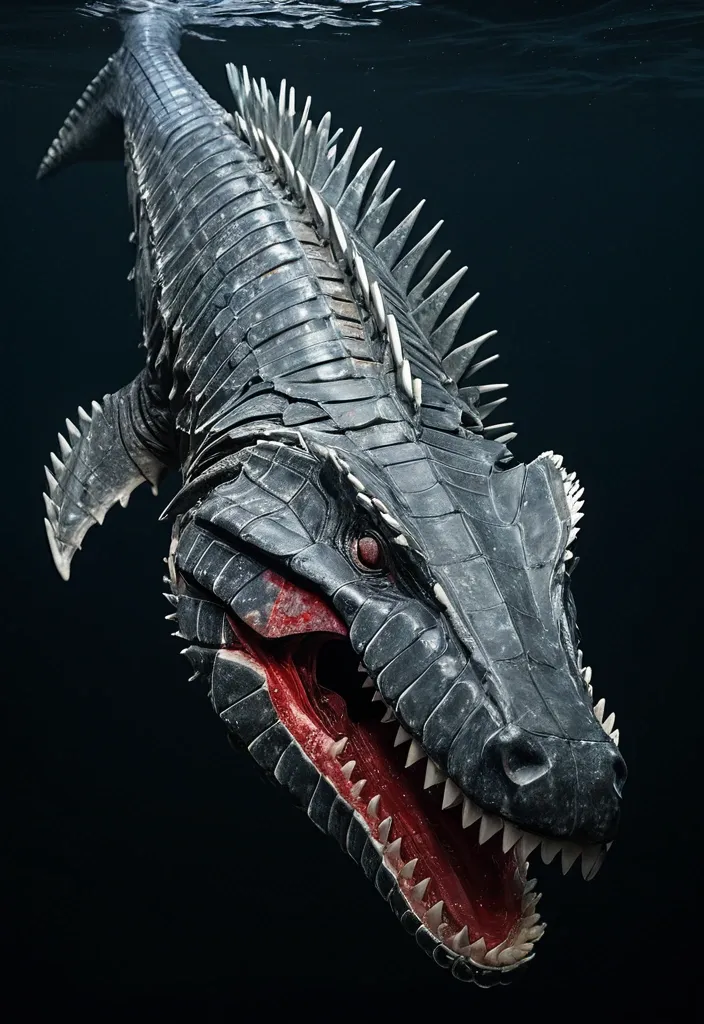
Female , Length: 40-60 feet , Weight: 50-75 tons , Lifespan: 100-135 years , Color is a slate gray base with white and red photophores arranged in tiger stripe patterns along the flanks and dorsal ridge , glowing vividly in abyssal darkness , a Robust , muscular frame combining the thick , armored scales of saltwater crocodile and arapaima with a hydrodynamic , flexible body of Mosasaurus Hoffmannii , Large , rigid pectoral fins capable of tilting backward to reduce drag , inspired by the Black Marlin’s speed adaptations , Powerful flippers adapted for both swimming and short-distance land movement , similar to a leopard seal’s scooting style , Enormous , reinforced jaws with over 40 , 000 PSI bite force , lined with long , razor-sharp canine teeth from Predator X and Megalodon genetics , Venomous spines inspired by the crown-of-thorns starfish line the dorsal ridge , delivering painful wounds to predators or rivals. ,
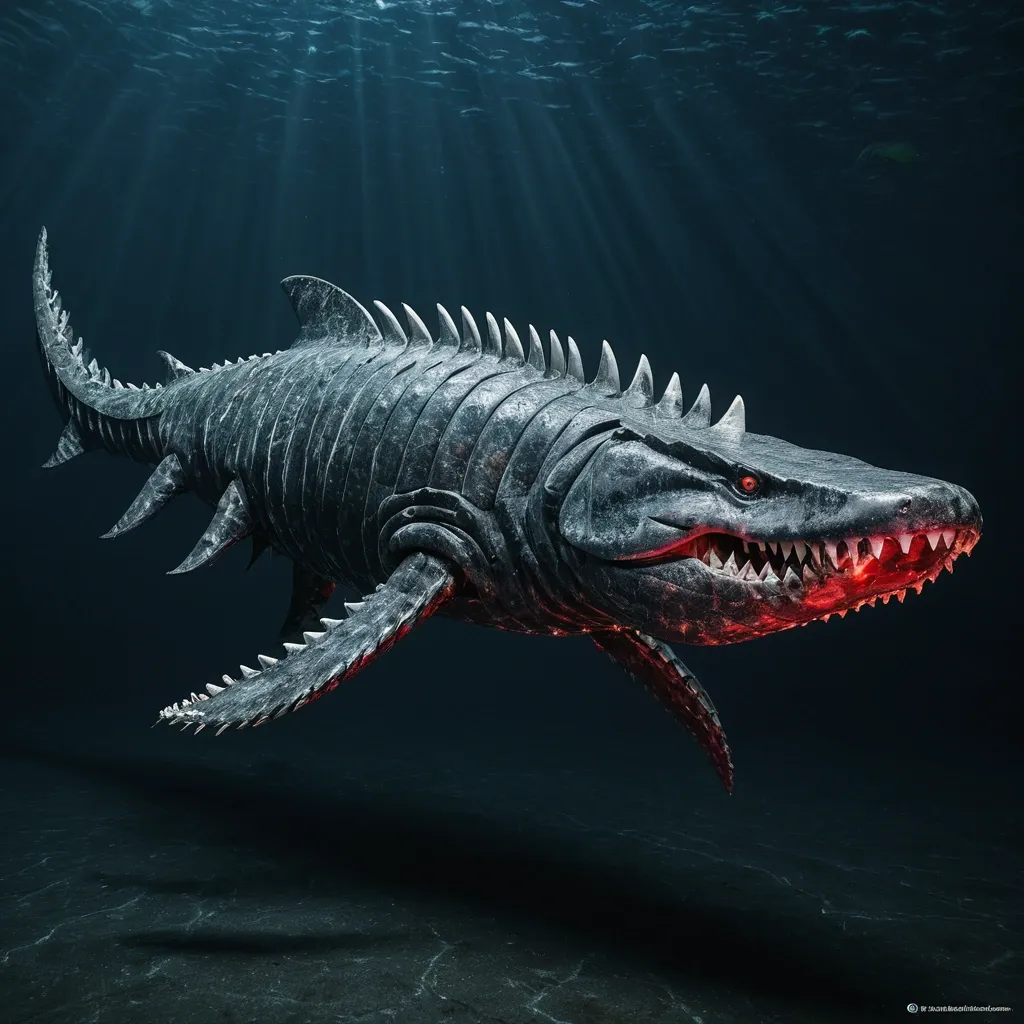
Female , Length: 40-60 feet , Weight: 50-75 tons , Lifespan: 100-135 years , Color is a slate gray base with white and red photophores arranged in tiger stripe patterns along the flanks and dorsal ridge , glowing vividly in abyssal darkness , a Robust , muscular frame combining the thick , armored scales of saltwater crocodile and arapaima with a hydrodynamic , flexible body of Mosasaurus Hoffmannii , Large , rigid pectoral fins capable of tilting backward to reduce drag , inspired by the Black Marlin’s speed adaptations , Powerful flippers adapted for both swimming and short-distance land movement , similar to a leopard seal’s scooting style , Enormous , reinforced jaws with over 40 , 000 PSI bite force , lined with long , razor-sharp canine teeth from Predator X and Megalodon genetics , Venomous spines inspired by the crown-of-thorns starfish line the dorsal ridge , delivering painful wounds to predators or rivals. ,
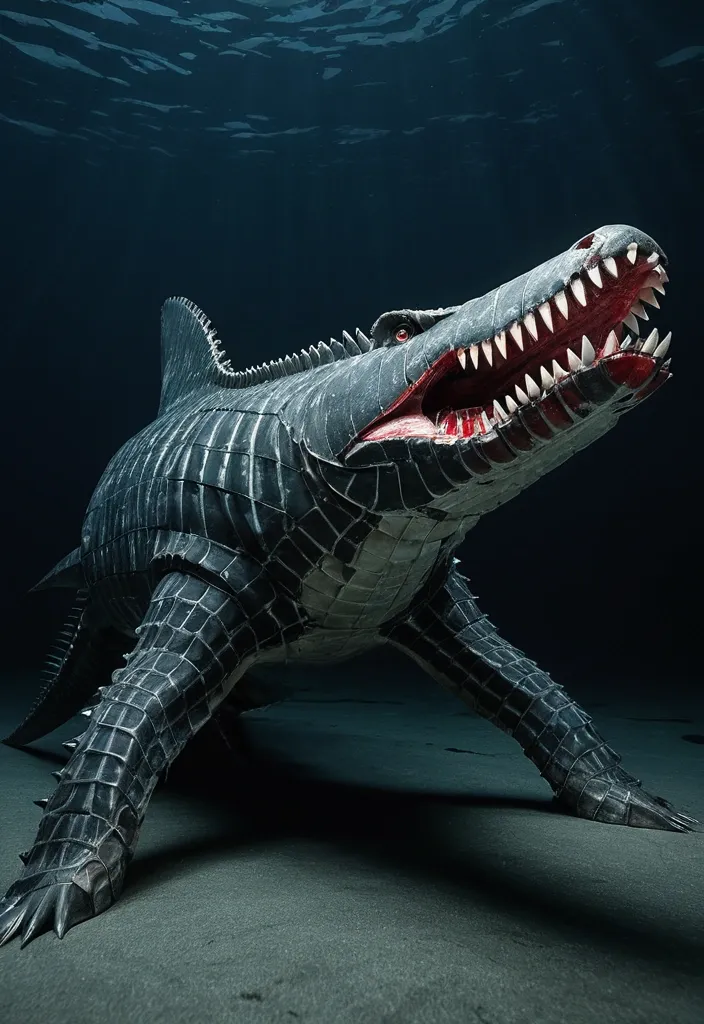
Female , Length: 40-60 feet , Weight: 50-75 tons , Lifespan: 100-135 years , Color is a slate gray base with white and red photophores arranged in tiger stripe patterns along the flanks and dorsal ridge , glowing vividly in abyssal darkness , a Robust , muscular frame combining the thick , armored scales of saltwater crocodile and arapaima with a hydrodynamic , flexible body of Mosasaurus Hoffmannii , Large , rigid pectoral fins capable of tilting backward to reduce drag , inspired by the Black Marlin’s speed adaptations , Powerful flippers adapted for both swimming and short-distance land movement , similar to a leopard seal’s scooting style , Enormous , reinforced jaws with over 40 , 000 PSI bite force , lined with long , razor-sharp canine teeth from Predator X and Megalodon genetics , Venomous spines inspired by the crown-of-thorns starfish line the dorsal ridge , delivering painful wounds to predators or rivals. ,
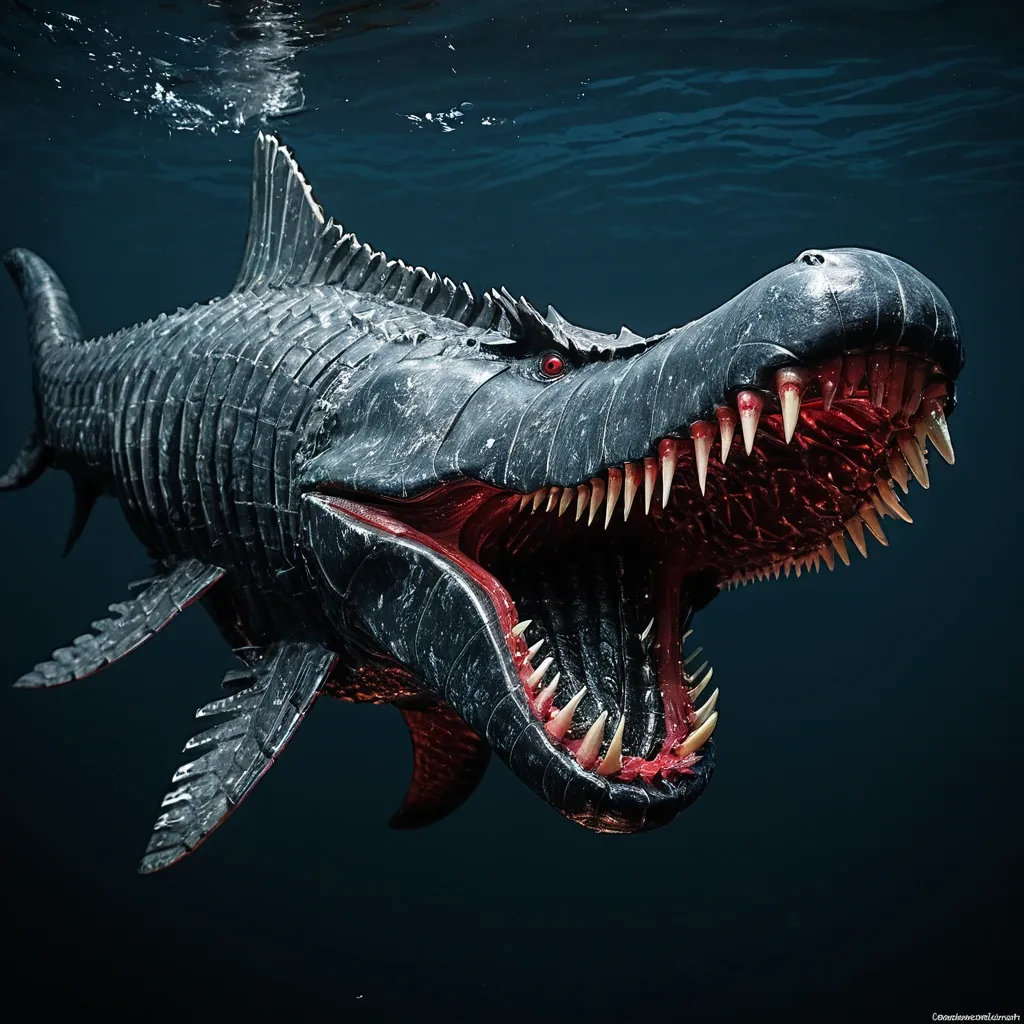
Males , Length: 40-60 feet , Weight: 50-75 tons , Lifespan: 100-135 years , Color is a Jet black base with red and light gray photophores arranged in a tiger stripe patterns along the flanks and dorsal ridge , glowing vividly in abyssal darkness , a streamlined , muscular frame combining the thick , armored scales of saltwater crocodile and arapaima with a hydrodynamic , flexible body of Mosasaurus Hoffmannii , Large , rigid pectoral fins capable of tilting backward to reduce drag , inspired by the Black Marlin’s speed adaptations , Powerful flippers adapted for both swimming and short-distance land movement , similar to a leopard seal’s scooting style , Enormous , reinforced jaws with over 40 , 000 PSI bite force , lined with long , razor-sharp canine teeth from Predator X and Megalodon genetics , Venomous spines inspired by the crown-of-thorns starfish line the dorsal ridge , delivering painful wounds to predators or rivals ,
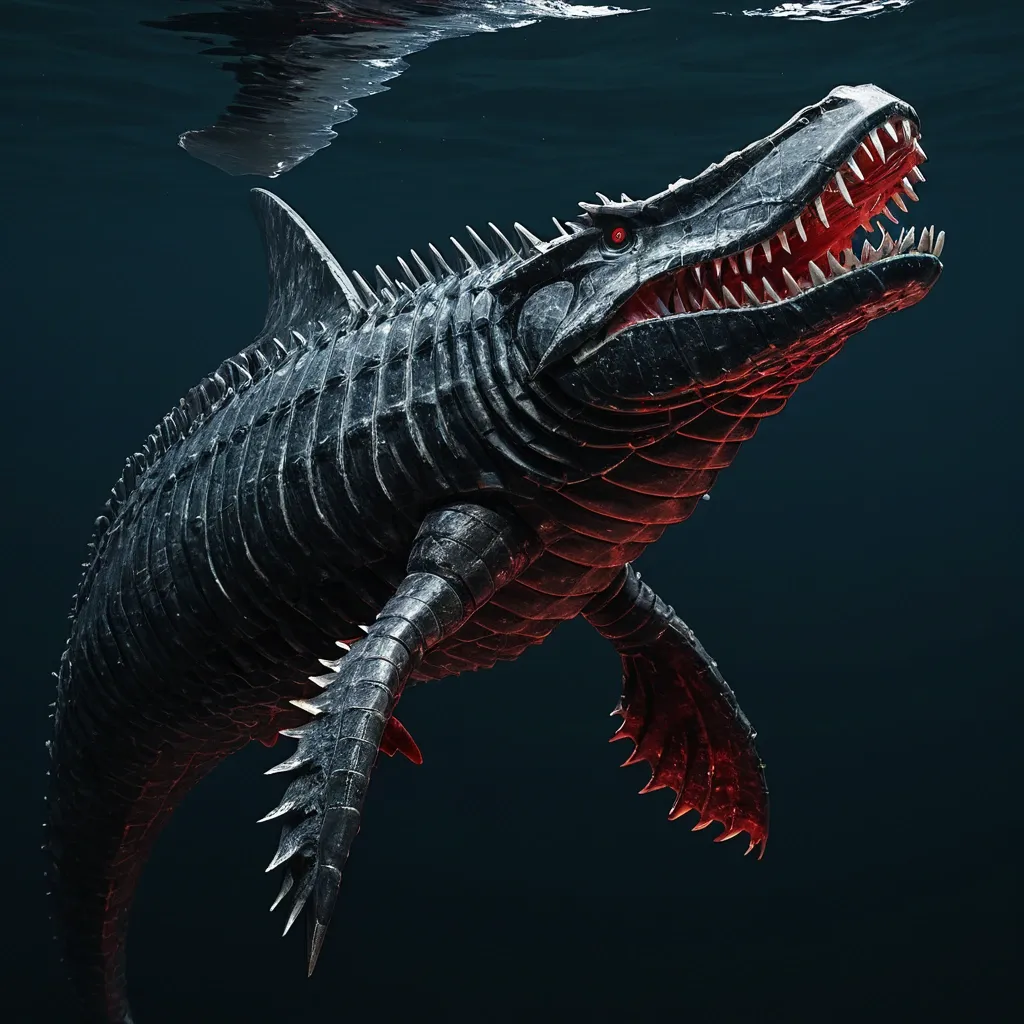
Males , Length: 40-60 feet , Weight: 50-75 tons , Lifespan: 100-135 years , Color is a Jet black base with red and light gray photophores arranged in a tiger stripe patterns along the flanks and dorsal ridge , glowing vividly in abyssal darkness , a streamlined , muscular frame combining the thick , armored scales of saltwater crocodile and arapaima with a hydrodynamic , flexible body of Mosasaurus Hoffmannii , Large , rigid pectoral fins capable of tilting backward to reduce drag , inspired by the Black Marlin’s speed adaptations , Powerful flippers adapted for both swimming and short-distance land movement , similar to a leopard seal’s scooting style , Enormous , reinforced jaws with over 40 , 000 PSI bite force , lined with long , razor-sharp canine teeth from Predator X and Megalodon genetics , Venomous spines inspired by the crown-of-thorns starfish line the dorsal ridge , delivering painful wounds to predators or rivals ,
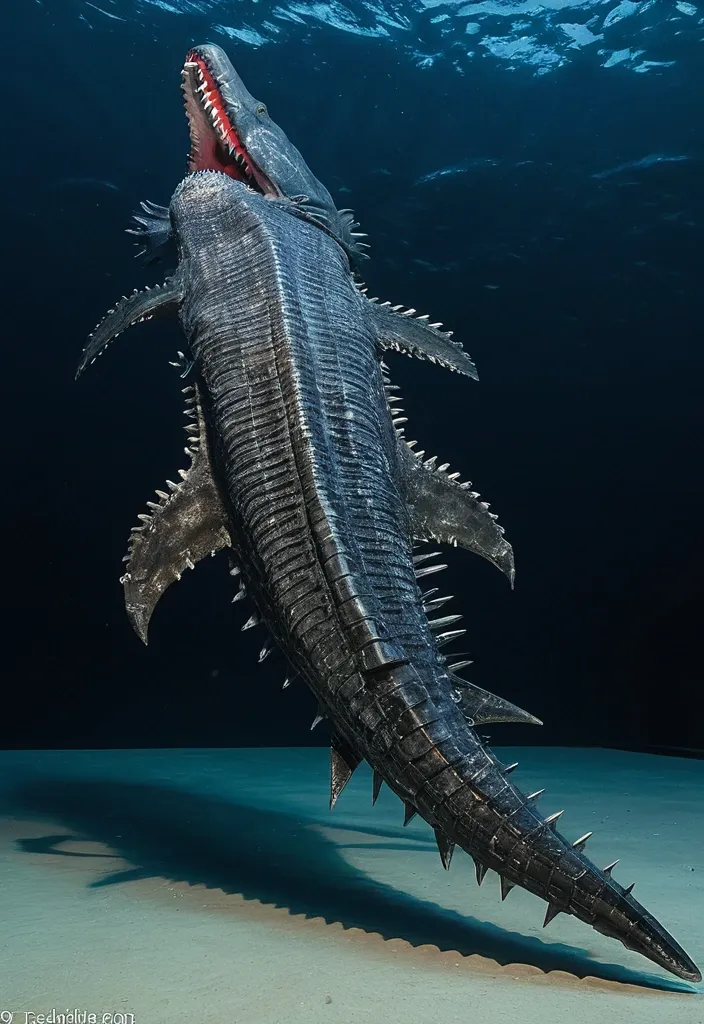
Males , Length: 40-60 feet , Weight: 50-75 tons , Lifespan: 100-135 years , Color is a Jet black base with red and light gray photophores arranged in a tiger stripe patterns along the flanks and dorsal ridge , glowing vividly in abyssal darkness , a streamlined , muscular frame combining the thick , armored scales of saltwater crocodile and arapaima with a hydrodynamic , flexible body of Mosasaurus Hoffmannii , Large , rigid pectoral fins capable of tilting backward to reduce drag , inspired by the Black Marlin’s speed adaptations , Powerful flippers adapted for both swimming and short-distance land movement , similar to a leopard seal’s scooting style , Enormous , reinforced jaws with over 40 , 000 PSI bite force , lined with long , razor-sharp canine teeth from Predator X and Megalodon genetics , Venomous spines inspired by the crown-of-thorns starfish line the dorsal ridge , delivering painful wounds to predators or rivals ,
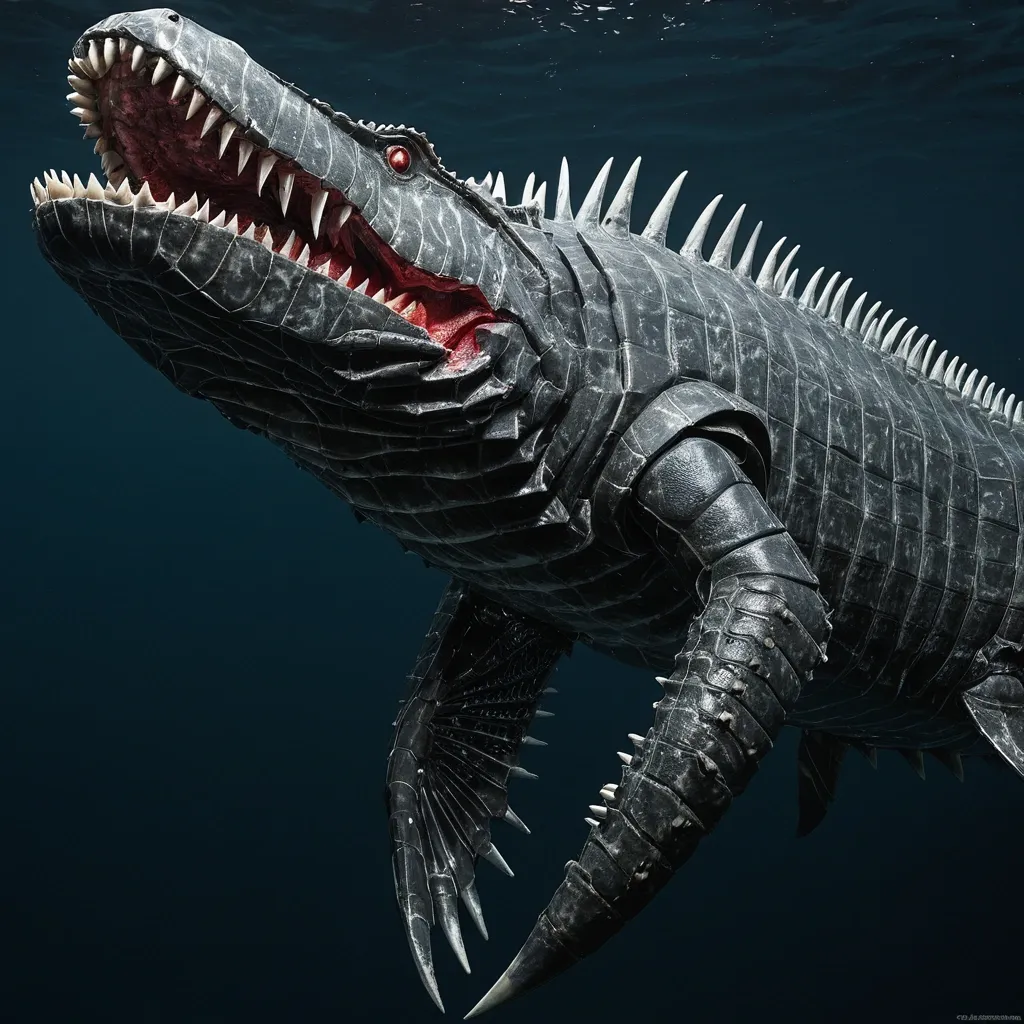
Female , Length: 40-60 feet , Weight: 50-75 tons , Lifespan: 100-135 years , Color is a slate gray base with white and red photophores arranged in tiger stripe patterns along the flanks and dorsal ridge , glowing vividly in abyssal darkness , a Robust , muscular frame combining the thick , armored scales of saltwater crocodile and arapaima with a hydrodynamic , flexible body of Mosasaurus Hoffmannii , Large , rigid pectoral fins capable of tilting backward to reduce drag , inspired by the Black Marlin’s speed adaptations , Powerful flippers adapted for both swimming and short-distance land movement , similar to a leopard seal’s scooting style , Enormous , reinforced jaws with over 40 , 000 PSI bite force , lined with long , razor-sharp canine teeth from Predator X and Megalodon genetics , Venomous spines inspired by the crown-of-thorns starfish line the dorsal ridge , delivering painful wounds to predators or rivals. ,
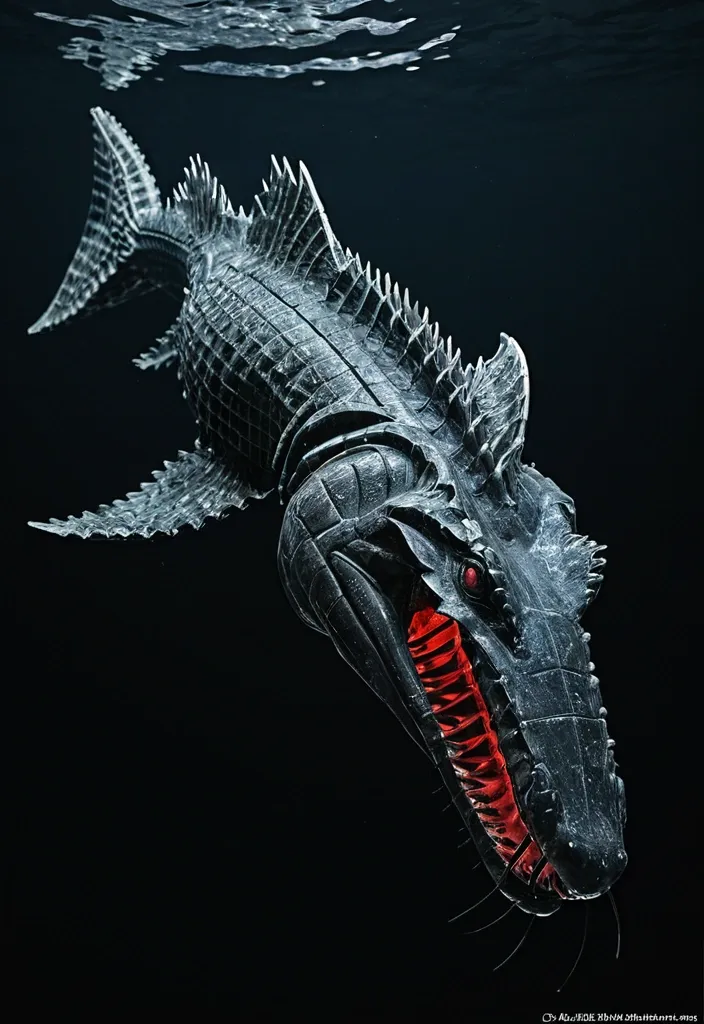
Males , Length: 40-60 feet , Weight: 50-75 tons , Lifespan: 100-135 years , Color is a Jet black base with red and light gray photophores arranged in a tiger stripe patterns along the flanks and dorsal ridge , glowing vividly in abyssal darkness , a streamlined , muscular frame combining the thick , armored scales of saltwater crocodile and arapaima with a hydrodynamic , flexible body of Mosasaurus Hoffmannii , Large , rigid pectoral fins capable of tilting backward to reduce drag , inspired by the Black Marlin’s speed adaptations , Powerful flippers adapted for both swimming and short-distance land movement , similar to a leopard seal’s scooting style , Enormous , reinforced jaws with over 40 , 000 PSI bite force , lined with long , razor-sharp canine teeth from Predator X and Megalodon genetics , Venomous spines inspired by the crown-of-thorns starfish line the dorsal ridge , delivering painful wounds to predators or rivals ,
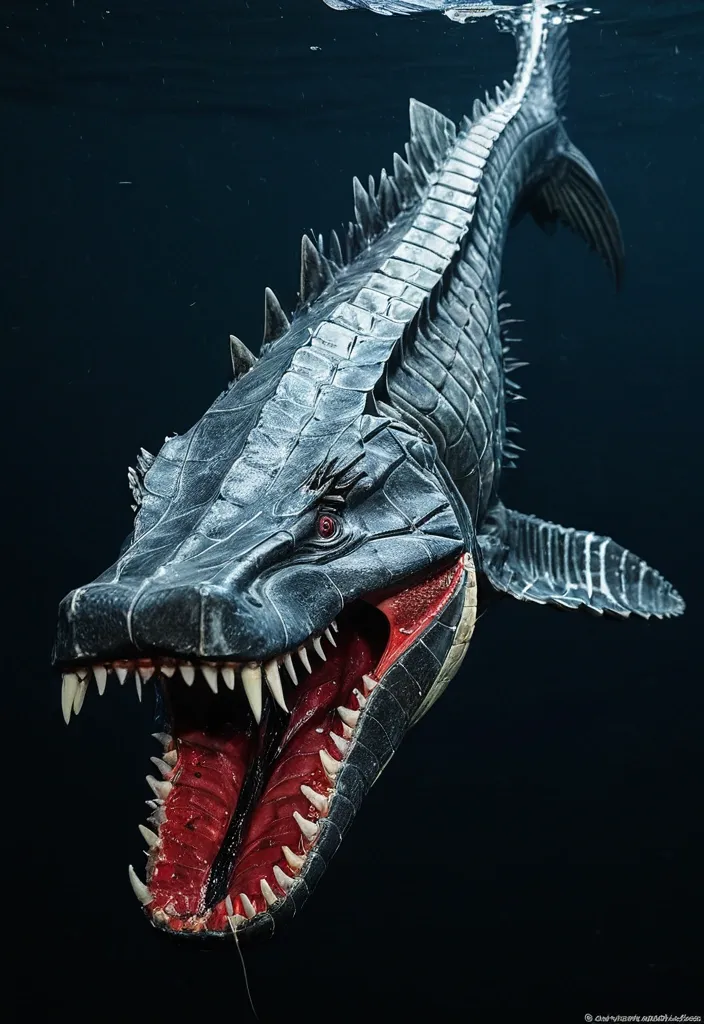
Males , Length: 40-60 feet , Weight: 50-75 tons , Lifespan: 100-135 years , Color is a Jet black base with red and light gray photophores arranged in a tiger stripe patterns along the flanks and dorsal ridge , glowing vividly in abyssal darkness , a streamlined , muscular frame combining the thick , armored scales of saltwater crocodile and arapaima with a hydrodynamic , flexible body of Mosasaurus Hoffmannii , Large , rigid pectoral fins capable of tilting backward to reduce drag , inspired by the Black Marlin’s speed adaptations , Powerful flippers adapted for both swimming and short-distance land movement , similar to a leopard seal’s scooting style , Enormous , reinforced jaws with over 40 , 000 PSI bite force , lined with long , razor-sharp canine teeth from Predator X and Megalodon genetics , Venomous spines inspired by the crown-of-thorns starfish line the dorsal ridge , delivering painful wounds to predators or rivals ,
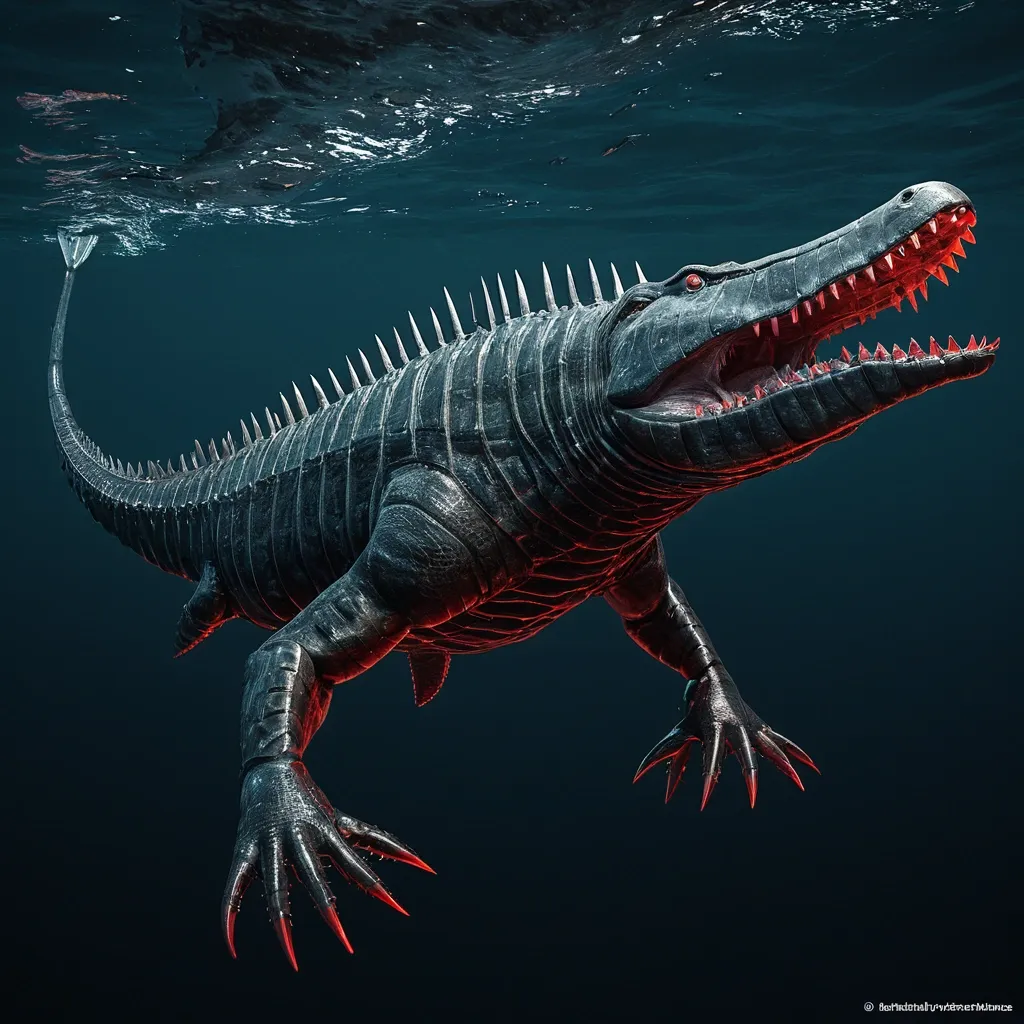
Males , Length: 40-60 feet , Weight: 50-75 tons , Lifespan: 100-135 years , Color is a Jet black base with Bioluminescent red and light gray photophores arranged in tiger stripe patterns along the flanks and dorsal ridge , glowing vividly in abyssal darkness , streamlined , muscular frame combining the thick , armored scales of saltwater crocodile and arapaima with a hydrodynamic , flexible body of Mosasaurus Hoffmannii , Large , rigid pectoral fins capable of tilting backward to reduce drag , inspired by the Black Marlin’s speed adaptations , Powerful flippers adapted for both swimming and short-distance land movement , similar to a leopard seal’s scooting style , Enormous , reinforced jaws with over 40 , 000 PSI bite force , lined with long , razor-sharp canine teeth from Predator X and Megalodon genetics , Venomous spines inspired by the crown-of-thorns starfish line the dorsal ridge , delivering painful wounds to predators or rivals ,
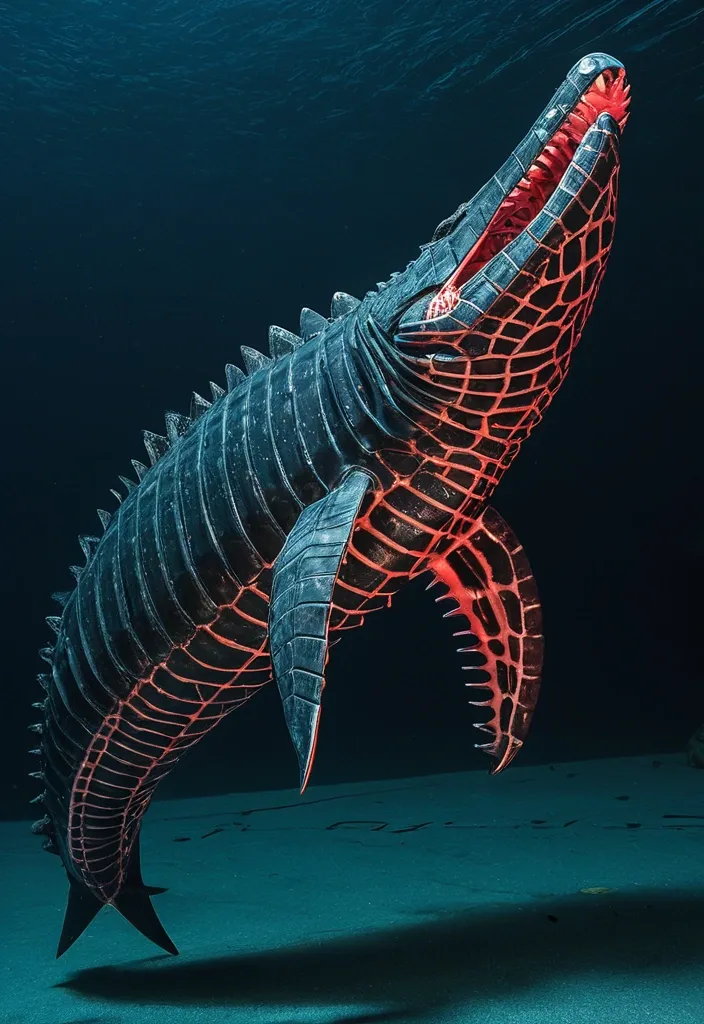
Males , Length: 40-60 feet , Weight: 50-75 tons , Lifespan: 100-135 years , Color is a Jet black base with Bioluminescent red and light gray photophores arranged in tiger stripe patterns along the flanks and dorsal ridge , glowing vividly in abyssal darkness , streamlined , muscular frame combining the thick , armored scales of saltwater crocodile and arapaima with a hydrodynamic , flexible body of Mosasaurus Hoffmannii , Large , rigid pectoral fins capable of tilting backward to reduce drag , inspired by the Black Marlin’s speed adaptations , Powerful flippers adapted for both swimming and short-distance land movement , similar to a leopard seal’s scooting style , Enormous , reinforced jaws with over 40 , 000 PSI bite force , lined with long , razor-sharp canine teeth from Predator X and Megalodon genetics , Venomous spines inspired by the crown-of-thorns starfish line the dorsal ridge , delivering painful wounds to predators or rivals ,
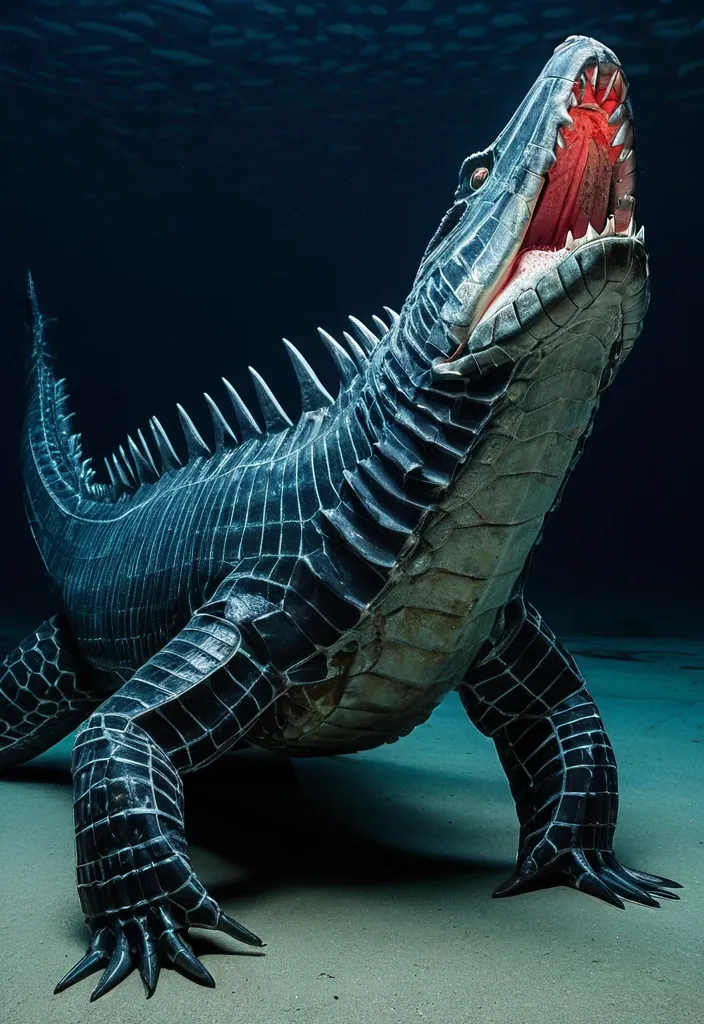
Males , Length: 40-60 feet , Weight: 50-75 tons , Lifespan: 100-135 years , Color is a Jet black base with Bioluminescent red and light gray photophores arranged in tiger stripe patterns along the flanks and dorsal ridge , glowing vividly in abyssal darkness , streamlined , muscular frame combining the thick , armored scales of saltwater crocodile and arapaima with a hydrodynamic , flexible body of Mosasaurus Hoffmannii , Large , rigid pectoral fins capable of tilting backward to reduce drag , inspired by the Black Marlin’s speed adaptations , Powerful flippers adapted for both swimming and short-distance land movement , similar to a leopard seal’s scooting style , Enormous , reinforced jaws with over 40 , 000 PSI bite force , lined with long , razor-sharp canine teeth from Predator X and Megalodon genetics , Venomous spines inspired by the crown-of-thorns starfish line the dorsal ridge , delivering painful wounds to predators or rivals ,
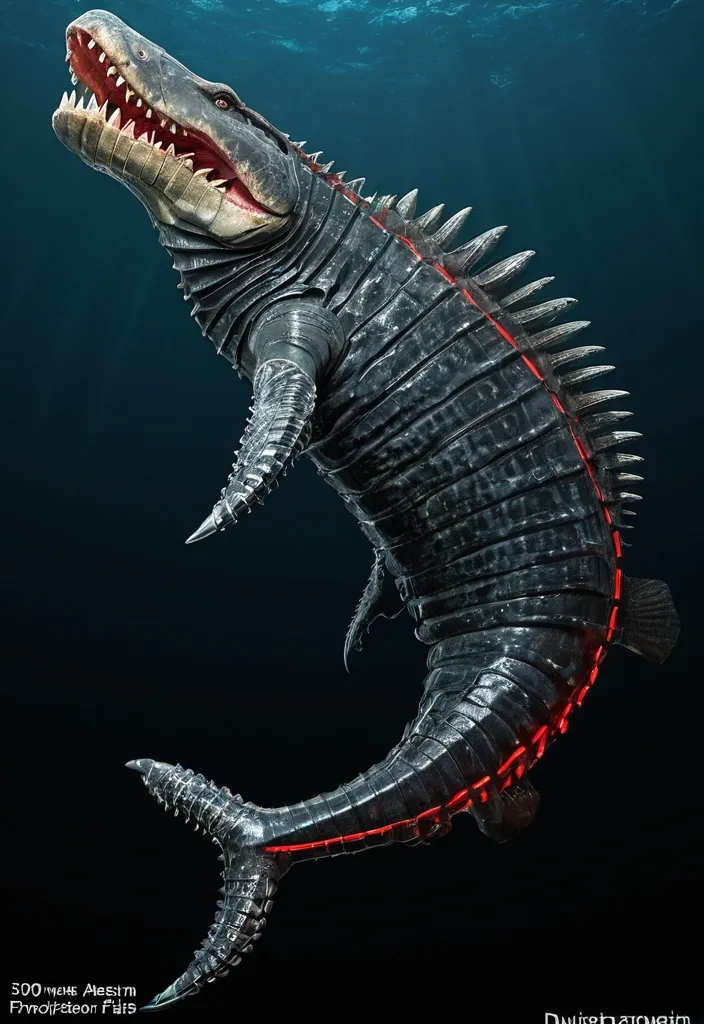
Males , Length: 40-60 feet , Weight: 50-75 tons , Lifespan: 100-135 years , Color is a Jet black base with Bioluminescent red and light gray photophores arranged in tiger stripe patterns along the flanks and dorsal ridge , glowing vividly in abyssal darkness , streamlined , muscular frame combining the thick , armored scales of saltwater crocodile and arapaima with a hydrodynamic , flexible body of Mosasaurus Hoffmannii , Large , rigid pectoral fins capable of tilting backward to reduce drag , inspired by the Black Marlin’s speed adaptations , Powerful flippers adapted for both swimming and short-distance land movement , similar to a leopard seal’s scooting style , Enormous , reinforced jaws with over 40 , 000 PSI bite force , lined with long , razor-sharp canine teeth from Predator X and Megalodon genetics , Venomous spines inspired by the crown-of-thorns starfish line the dorsal ridge , delivering painful wounds to predators or rivals ,
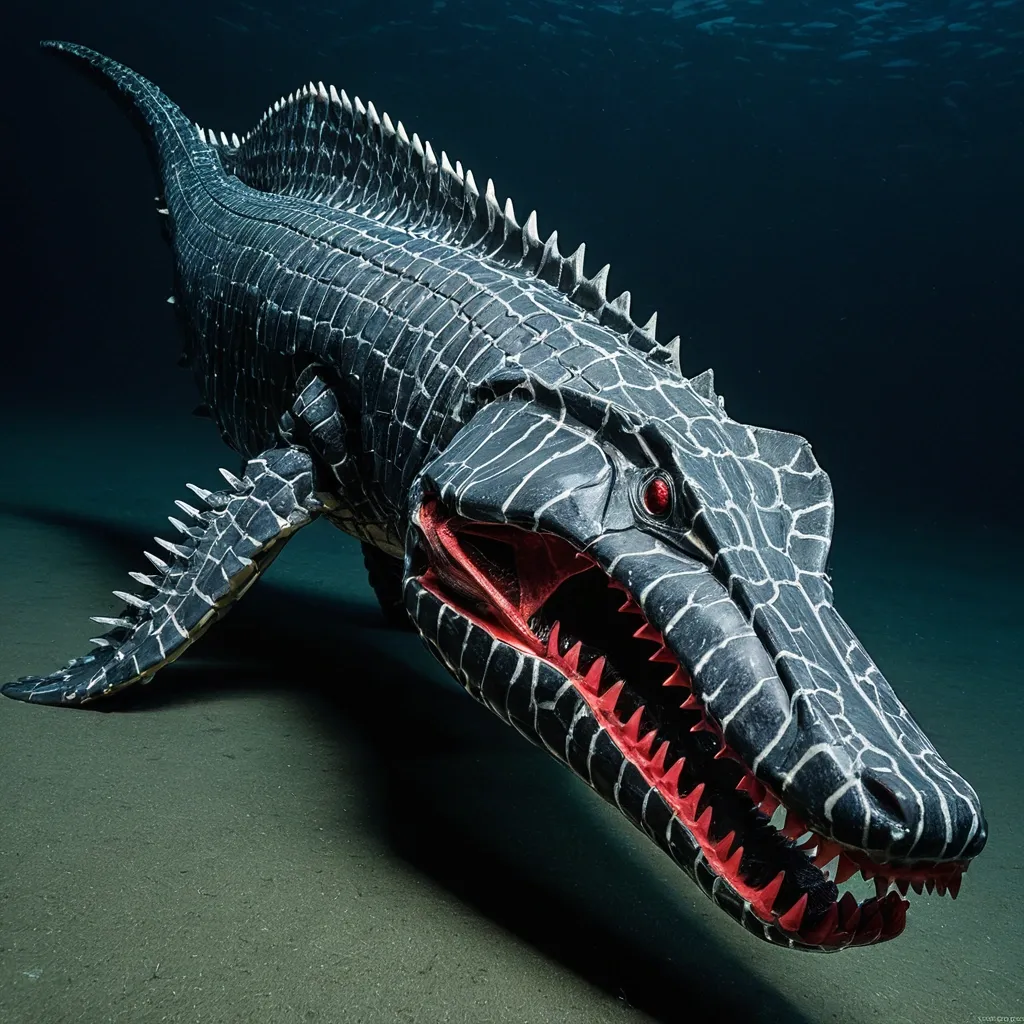
Males , Length: 40-60 feet , Weight: 50-75 tons , Lifespan: 100-135 years , Color is a Jet black base with Bioluminescent red and light gray photophores arranged in tiger stripe patterns along the flanks and dorsal ridge , glowing vividly in abyssal darkness , streamlined , muscular frame combining the thick , armored scales of saltwater crocodile and arapaima with a hydrodynamic , flexible body of Mosasaurus Hoffmannii , Large , rigid pectoral fins capable of tilting backward to reduce drag , inspired by the Black Marlin’s speed adaptations , Powerful flippers adapted for both swimming and short-distance land movement , similar to a leopard seal’s scooting style , Enormous , reinforced jaws with over 40 , 000 PSI bite force , lined with long , razor-sharp canine teeth from Predator X and Megalodon genetics , Venomous spines inspired by the crown-of-thorns starfish line the dorsal ridge , delivering painful wounds to predators or rivals ,
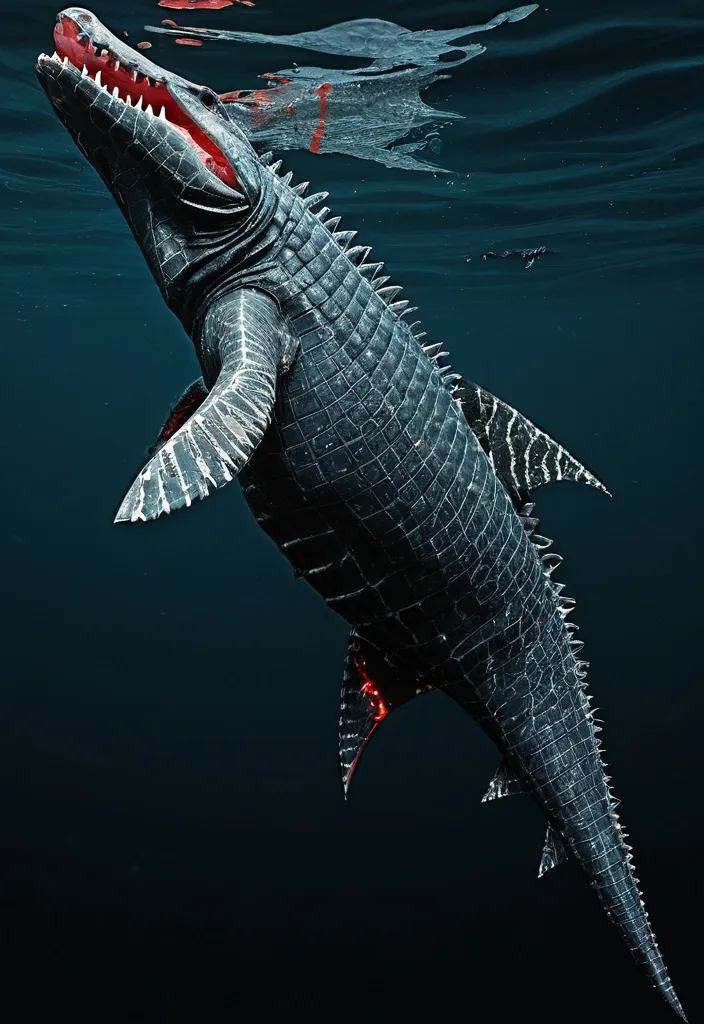
Males , Length: 40-60 feet , Weight: 50-75 tons , Lifespan: 100-135 years , Color is a Jet black base with Bioluminescent red and light gray photophores arranged in tiger stripe patterns along the flanks and dorsal ridge , glowing vividly in abyssal darkness , streamlined , muscular frame combining the thick , armored scales of saltwater crocodile and arapaima with a hydrodynamic , flexible body of Mosasaurus Hoffmannii , Large , rigid pectoral fins capable of tilting backward to reduce drag , inspired by the Black Marlin’s speed adaptations , Powerful flippers adapted for both swimming and short-distance land movement , similar to a leopard seal’s scooting style , Enormous , reinforced jaws with over 40 , 000 PSI bite force , lined with long , razor-sharp canine teeth from Predator X and Megalodon genetics , Venomous spines inspired by the crown-of-thorns starfish line the dorsal ridge , delivering painful wounds to predators or rivals ,
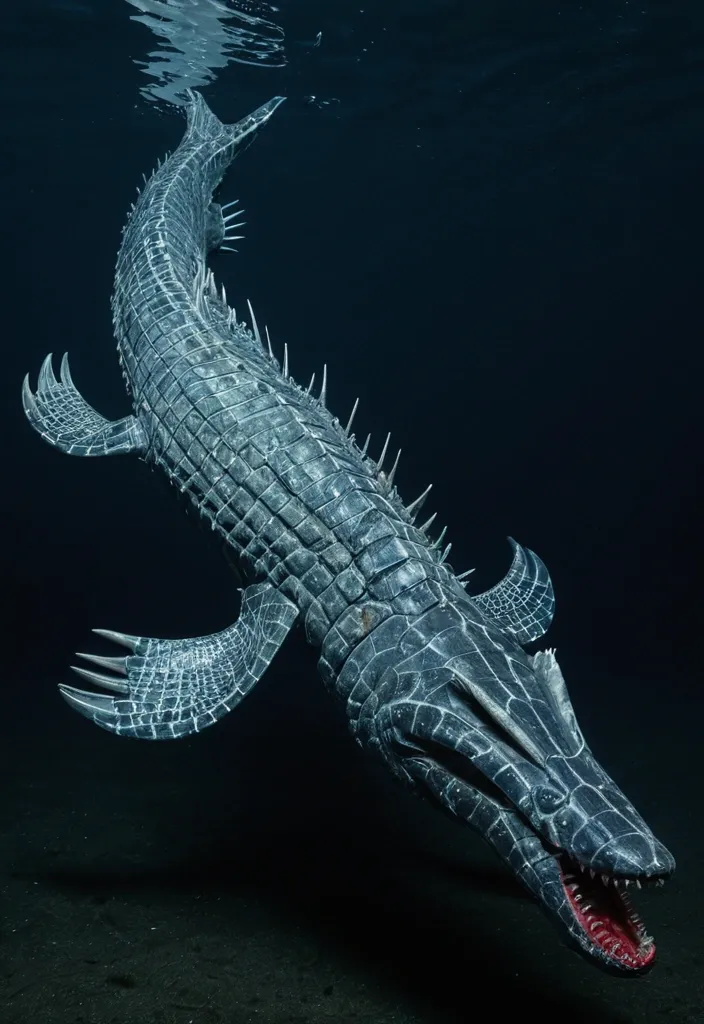
Female , Length: 40-60 feet , Weight: 50-75 tons , Lifespan: 100-135 years , Color is a slate gray base with Bioluminescent white and red photophores arranged in tiger stripe patterns along the flanks and dorsal ridge , glowing vividly in abyssal darkness , Robust , muscular frame combining the thick , armored scales of saltwater crocodile and arapaima with a hydrodynamic , flexible body of Mosasaurus Hoffmannii , Large , rigid pectoral fins capable of tilting backward to reduce drag , inspired by the Black Marlin’s speed adaptations , Powerful flippers adapted for both swimming and short-distance land movement , similar to a leopard seal’s scooting style , Enormous , reinforced jaws with over 40 , 000 PSI bite force , lined with long , razor-sharp canine teeth from Predator X and Megalodon genetics , Venomous spines inspired by the crown-of-thorns starfish line the dorsal ridge , delivering painful wounds to predators or rivals. ,
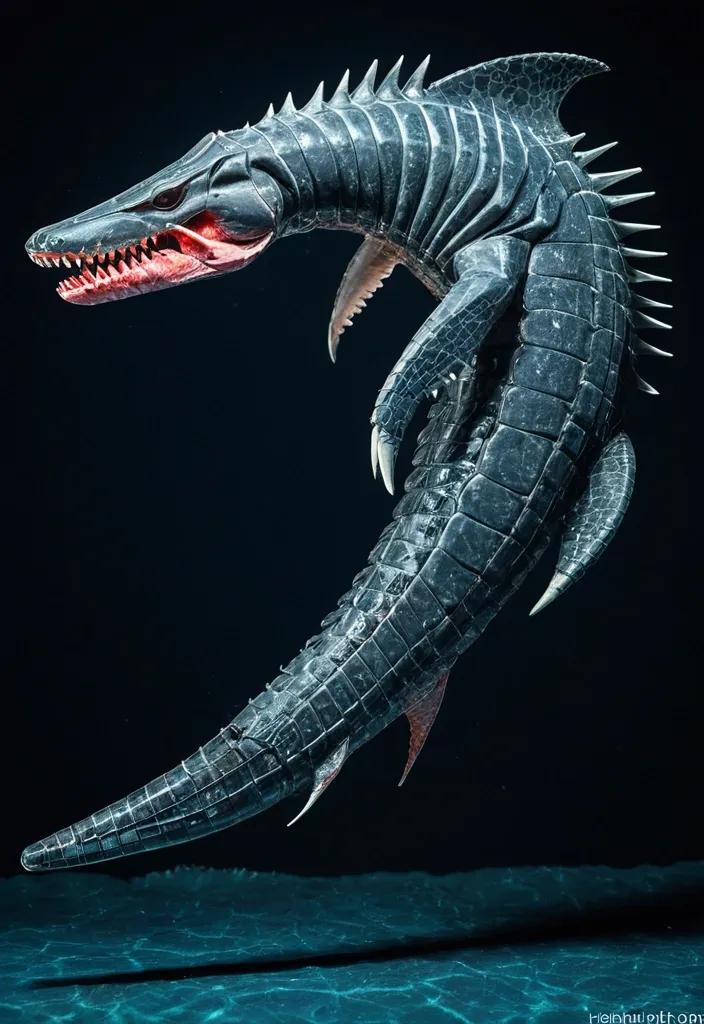
Female , Length: 40-60 feet , Weight: 50-75 tons , Lifespan: 100-135 years , Color is a slate gray base with Bioluminescent white and red photophores arranged in tiger stripe patterns along the flanks and dorsal ridge , glowing vividly in abyssal darkness , Robust , muscular frame combining the thick , armored scales of saltwater crocodile and arapaima with a hydrodynamic , flexible body of Mosasaurus Hoffmannii , Large , rigid pectoral fins capable of tilting backward to reduce drag , inspired by the Black Marlin’s speed adaptations , Powerful flippers adapted for both swimming and short-distance land movement , similar to a leopard seal’s scooting style , Enormous , reinforced jaws with over 40 , 000 PSI bite force , lined with long , razor-sharp canine teeth from Predator X and Megalodon genetics , Venomous spines inspired by the crown-of-thorns starfish line the dorsal ridge , delivering painful wounds to predators or rivals. ,
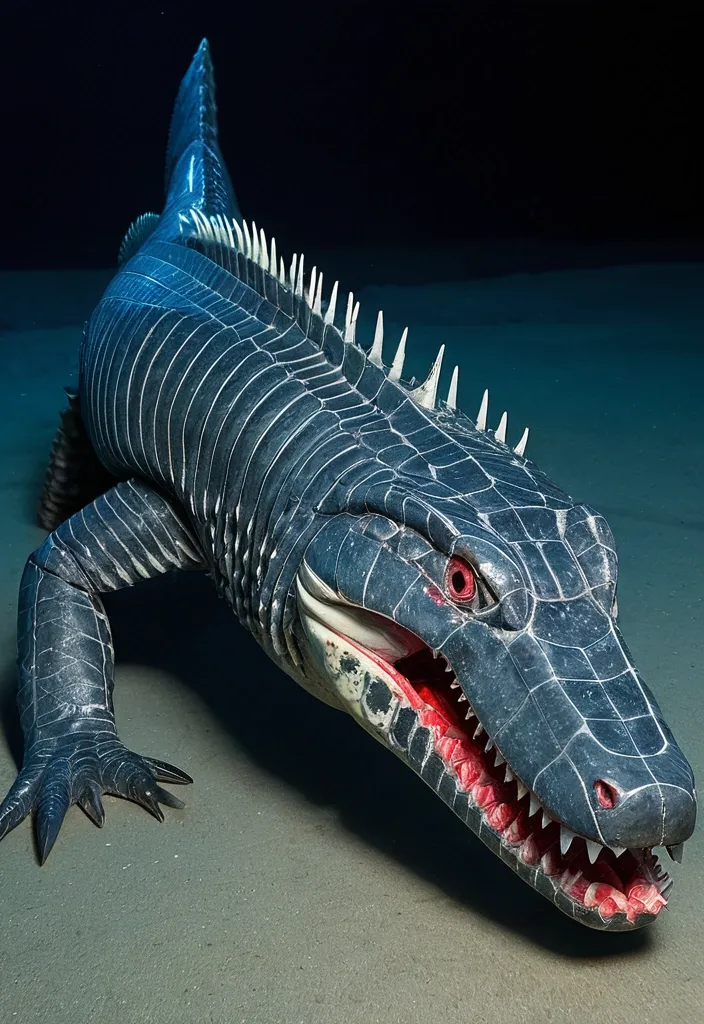
Female , Length: 40-60 feet , Weight: 50-75 tons , Lifespan: 100-135 years , Color is a slate gray base with Bioluminescent white and red photophores arranged in tiger stripe patterns along the flanks and dorsal ridge , glowing vividly in abyssal darkness , Robust , muscular frame combining the thick , armored scales of saltwater crocodile and arapaima with a hydrodynamic , flexible body of Mosasaurus Hoffmannii , Large , rigid pectoral fins capable of tilting backward to reduce drag , inspired by the Black Marlin’s speed adaptations , Powerful flippers adapted for both swimming and short-distance land movement , similar to a leopard seal’s scooting style , Enormous , reinforced jaws with over 40 , 000 PSI bite force , lined with long , razor-sharp canine teeth from Predator X and Megalodon genetics , Venomous spines inspired by the crown-of-thorns starfish line the dorsal ridge , delivering painful wounds to predators or rivals. ,
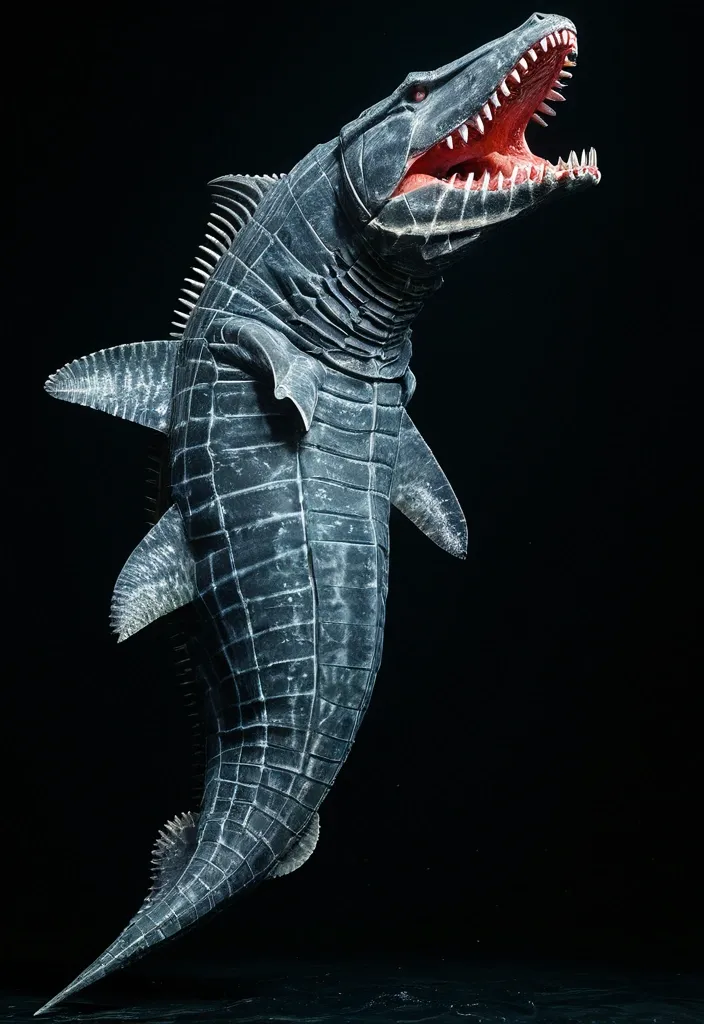
Female , Length: 40-60 feet , Weight: 50-75 tons , Lifespan: 100-135 years , Color is a slate gray base with Bioluminescent white and red photophores arranged in tiger stripe patterns along the flanks and dorsal ridge , glowing vividly in abyssal darkness , Robust , muscular frame combining the thick , armored scales of saltwater crocodile and arapaima with a hydrodynamic , flexible body of Mosasaurus Hoffmannii , Large , rigid pectoral fins capable of tilting backward to reduce drag , inspired by the Black Marlin’s speed adaptations , Powerful flippers adapted for both swimming and short-distance land movement , similar to a leopard seal’s scooting style , Enormous , reinforced jaws with over 40 , 000 PSI bite force , lined with long , razor-sharp canine teeth from Predator X and Megalodon genetics , Venomous spines inspired by the crown-of-thorns starfish line the dorsal ridge , delivering painful wounds to predators or rivals. ,
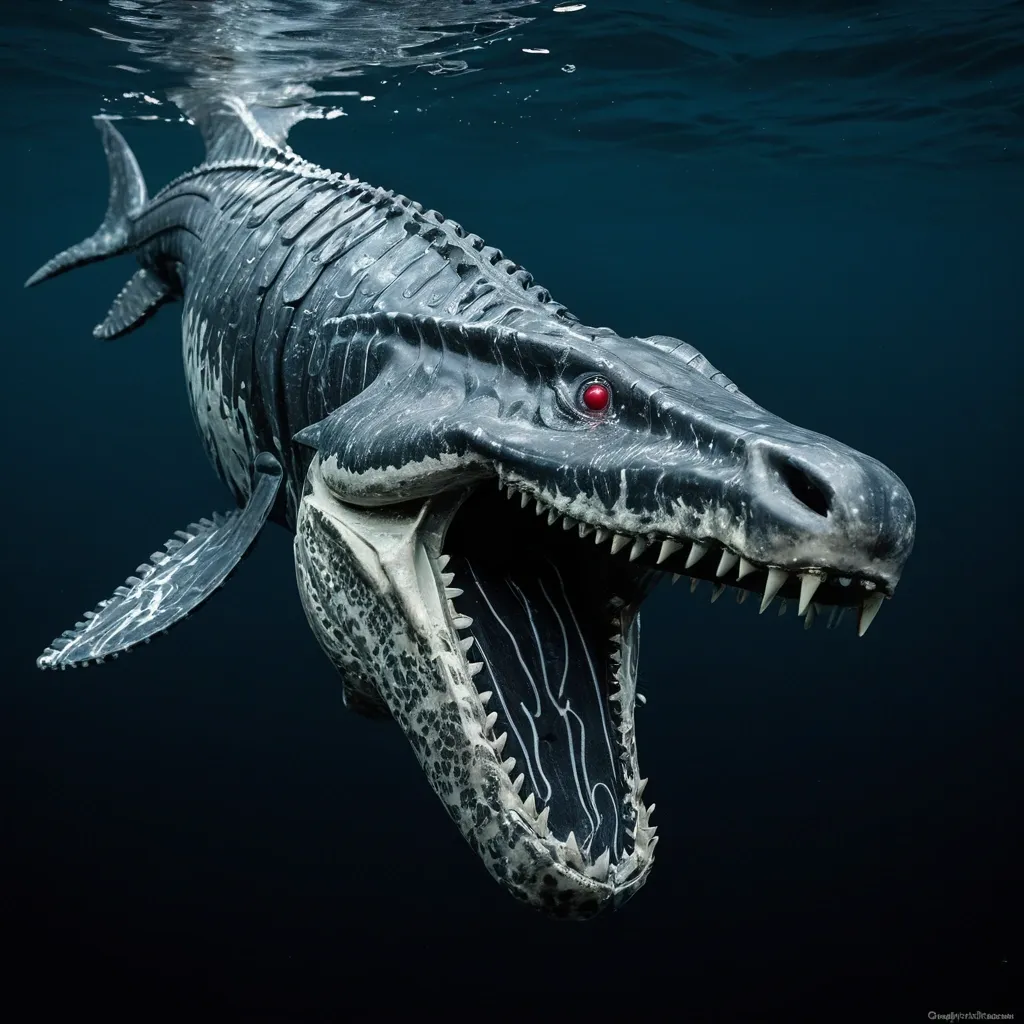
Length: 40-60 feetWeight: 50-75 tonsLifespan: 100-135 yearsColoration of the Females is Slate gray base with white tiger stripesBioluminescent red photophores arranged in tiger stripe patterns along the flanks and dorsal ridge , glowing vividly in abyssal darknessBody: Robust , muscular frame combining the thick , armored scales of saltwater crocodile with the hydrodynamic , flexible body of Mosasaurus HoffmanniiFins: Large , rigid pectoral fins capable of tilting backward to reduce drag , inspired by the Black Marlin’s speed adaptationsLimbs: Powerful flippers adapted for both swimming and short-distance land movement , similar to a leopard seal’s scooting styleJaw: Enormous , reinforced jaws with over 40 , 000 PSI bite force , lined with long , razor-sharp canine teeth from Predator X and Megalodon geneticsSkin: Coated with a thick mucus layer secreted like the Atlantic hagfish , providing parasite defense , moisture retention , and a slippery surface to evade predators and prey alikeRespiratory system: Dual-function lungs and gills allow breathing in surface air and extracting oxygen from water , enabling survival from ocean surface to depths up to 9 , 800 feetSensory: Passive listening capabilities from transient killer whale lineage enable near-silent hunting; bioluminescent photophores aid in communication and prey attraction in deep-sea darkness ,
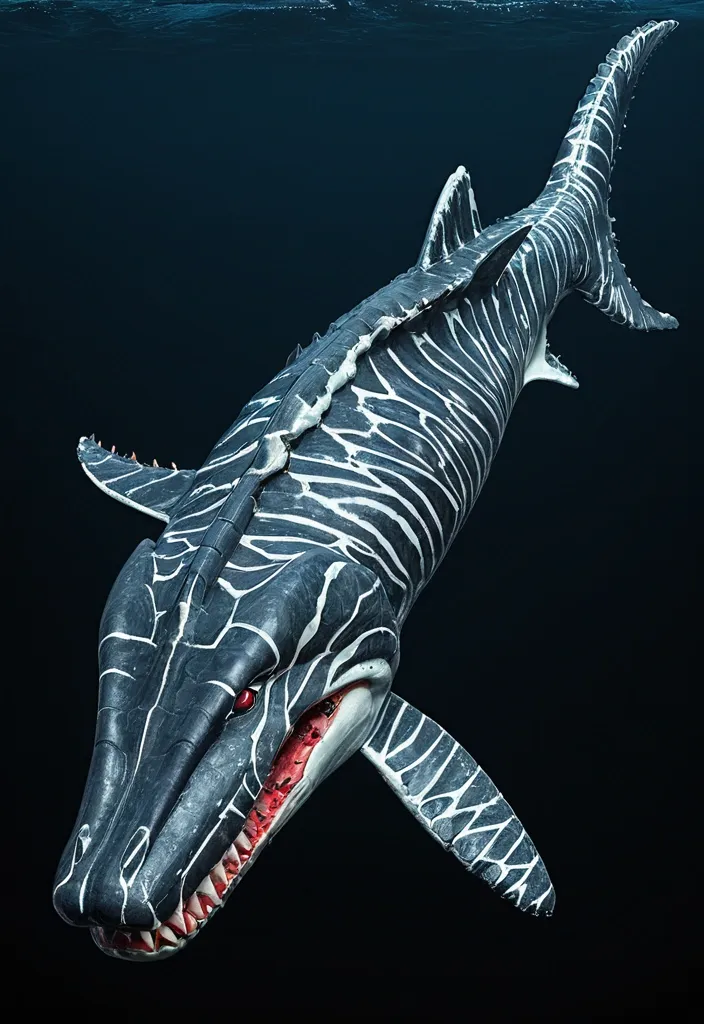
Length: 40-60 feetWeight: 50-75 tonsLifespan: 100-135 yearsColoration of the Females is Slate gray base with white tiger stripesBioluminescent red photophores arranged in tiger stripe patterns along the flanks and dorsal ridge , glowing vividly in abyssal darknessBody: Robust , muscular frame combining the thick , armored scales of saltwater crocodile with the hydrodynamic , flexible body of Mosasaurus HoffmanniiFins: Large , rigid pectoral fins capable of tilting backward to reduce drag , inspired by the Black Marlin’s speed adaptationsLimbs: Powerful flippers adapted for both swimming and short-distance land movement , similar to a leopard seal’s scooting styleJaw: Enormous , reinforced jaws with over 40 , 000 PSI bite force , lined with long , razor-sharp canine teeth from Predator X and Megalodon geneticsSkin: Coated with a thick mucus layer secreted like the Atlantic hagfish , providing parasite defense , moisture retention , and a slippery surface to evade predators and prey alikeRespiratory system: Dual-function lungs and gills allow breathing in surface air and extracting oxygen from water , enabling survival from ocean surface to depths up to 9 , 800 feetSensory: Passive listening capabilities from transient killer whale lineage enable near-silent hunting; bioluminescent photophores aid in communication and prey attraction in deep-sea darkness ,
